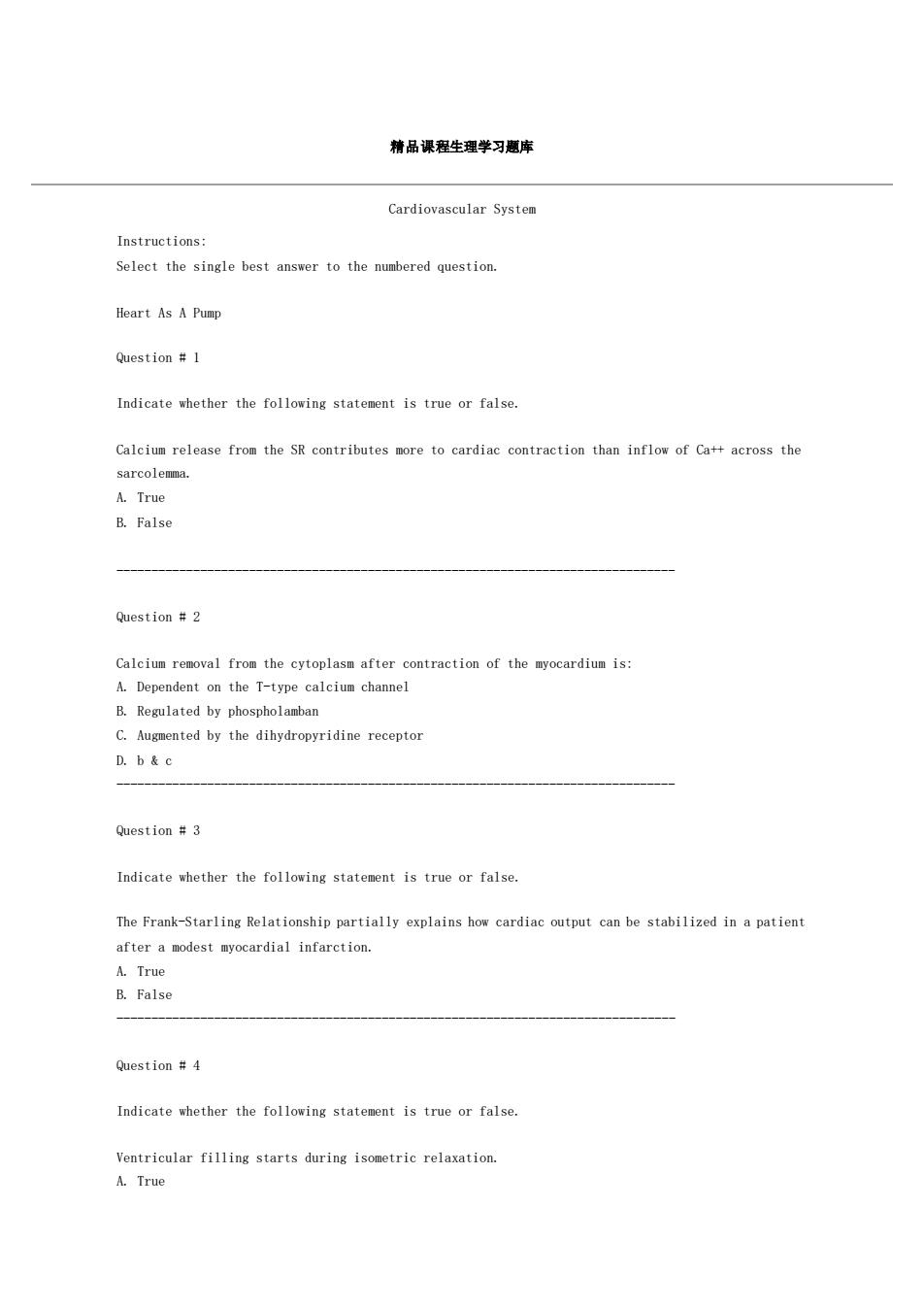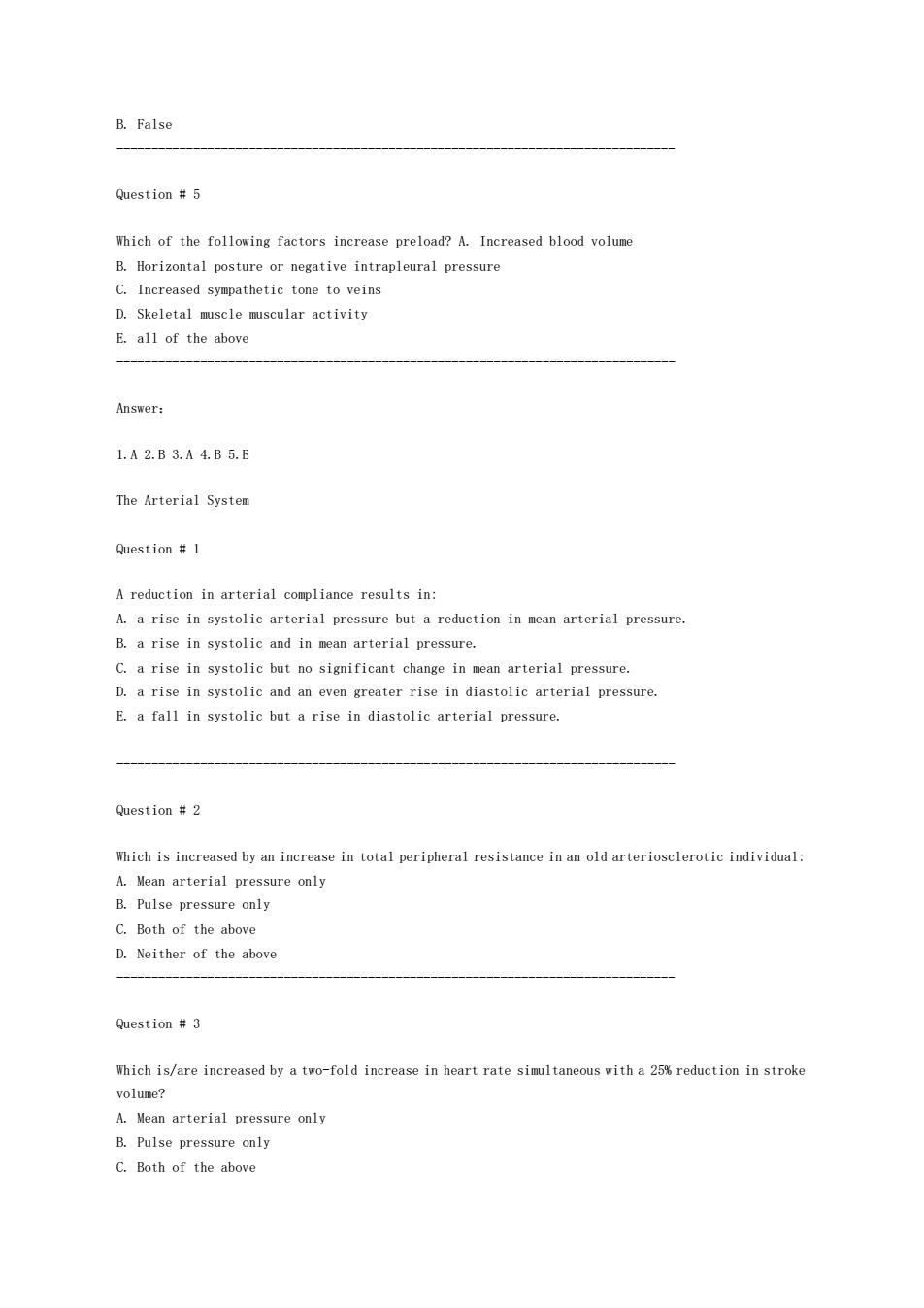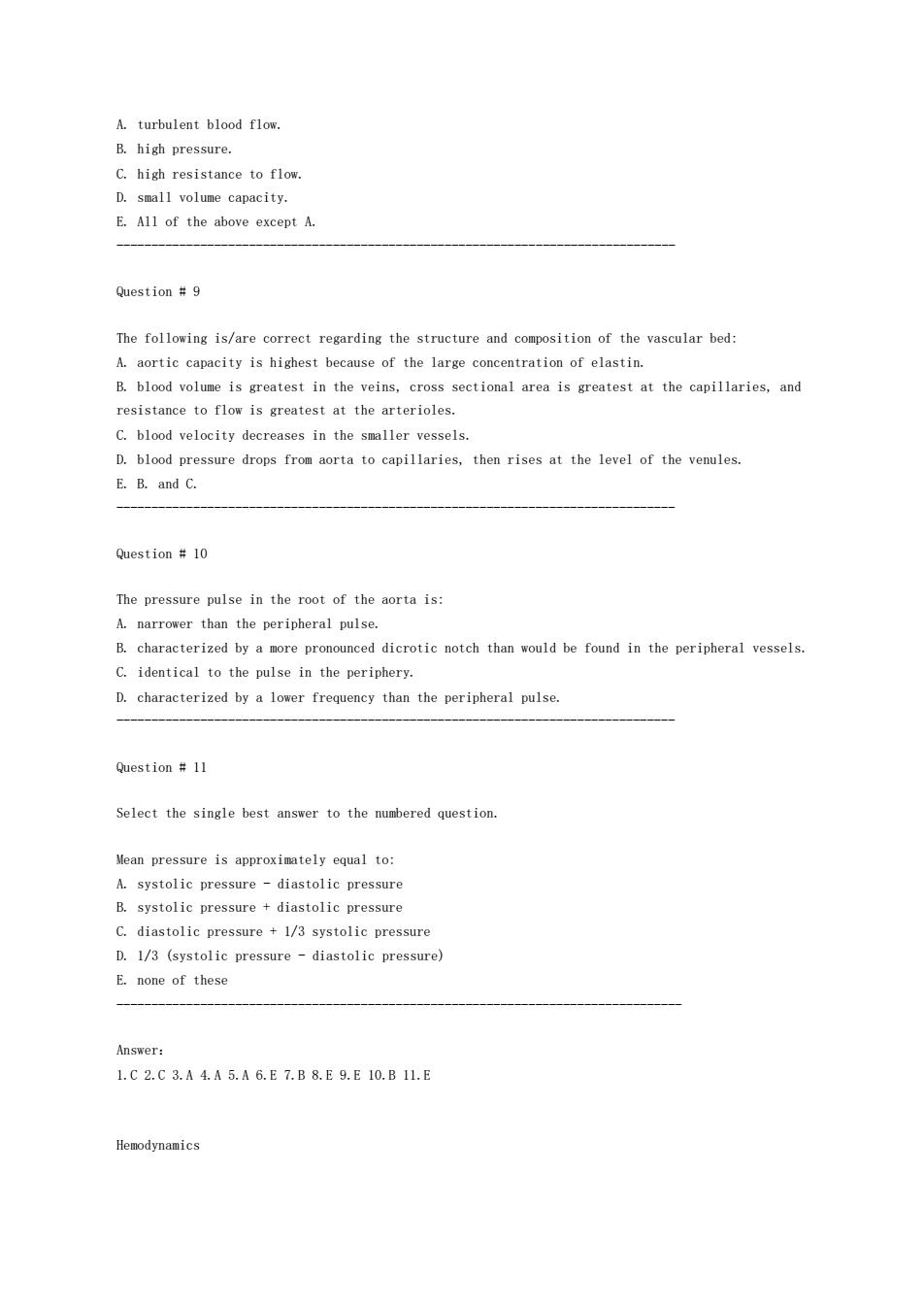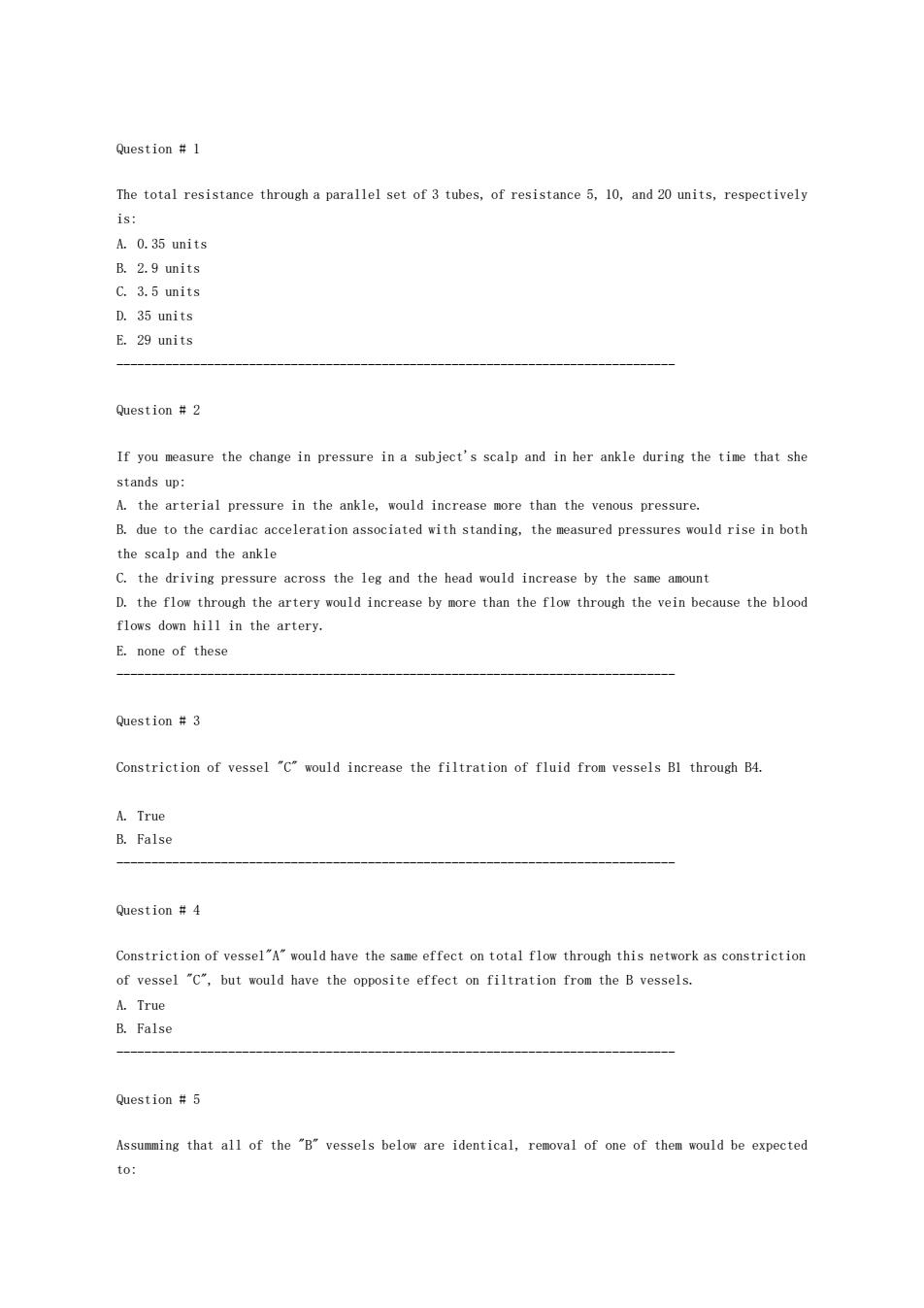
精品课程生理学习题库 Cardiovascular System Instructions: Select the single best answer to the numbered question. Heart As A Pur即 Question #1 Indicate whether the following statement is true or false. Calcium release from the SR contributes more to cardiac contraction than inflow of Ca++across the A.True B.False Question#2 Calcium reval from the cytoplasm after conraction of the cardu is: A.Dependent on the T-type calciun channel B.Regulated by phospholamban C.Augmented by the dihydropyridine receptor D.b&c Question#3 Indicate whether the following statement is true or false. The Frank-Starling Relationship partially explains how cardiac output can be stabilized in a patient after a modest mvocardial infarction. A.True B.False Question4 Indicate whether the following statement is true or false. Ventricular filling starts during isometric relaxation. A.True
精品课程生理学习题库 Cardiovascular System Instructions: Select the single best answer to the numbered question. Heart As A Pump Question # 1 Indicate whether the following statement is true or false. Calcium release from the SR contributes more to cardiac contraction than inflow of Ca++ across the sarcolemma. A. True B. False -------------------------------------------------------------------------------- Question # 2 Calcium removal from the cytoplasm after contraction of the myocardium is: A. Dependent on the T-type calcium channel B. Regulated by phospholamban C. Augmented by the dihydropyridine receptor D. b & c -------------------------------------------------------------------------------- Question # 3 Indicate whether the following statement is true or false. The Frank-Starling Relationship partially explains how cardiac output can be stabilized in a patient after a modest myocardial infarction. A. True B. False -------------------------------------------------------------------------------- Question # 4 Indicate whether the following statement is true or false. Ventricular filling starts during isometric relaxation. A. True

B.False Which of the folloing factors increase preload?A.Inereased blood volu B.Horizontal posture or negative intrapleural pressure C.Increased sympathetic tone to veins D.Skeletal auscle muscular activity E all of the above Answer: 1.A2.B3.A4.B5.E The Arterial System A reduction in arterial results in: A.a rise in systolic arterial pressure but a reduction in mean arterial pressure. B.a rise in systolic and in mean arterial pressure. C.a rise in systolic but no significant change in mean arterial pressure. D.a rise in systolic and an even greater rise in diastolic arterial pressure Question #2 Which is increased by an increase in total peripheral resistance in an old arteriosclerotic individual: omly C.Both of the above D.Neither of the above Question 3 hich is/are increased by a two-fold increase in heart rate simltaneous with a 25 reduction in stroke A Mean arterial pressure only B.Pulse pressure only C.Both of the above
B. False -------------------------------------------------------------------------------- Question # 5 Which of the following factors increase preload? A. Increased blood volume B. Horizontal posture or negative intrapleural pressure C. Increased sympathetic tone to veins D. Skeletal muscle muscular activity E. all of the above -------------------------------------------------------------------------------- Answer: 1.A 2.B 3.A 4.B 5.E The Arterial System Question # 1 A reduction in arterial compliance results in: A. a rise in systolic arterial pressure but a reduction in mean arterial pressure. B. a rise in systolic and in mean arterial pressure. C. a rise in systolic but no significant change in mean arterial pressure. D. a rise in systolic and an even greater rise in diastolic arterial pressure. E. a fall in systolic but a rise in diastolic arterial pressure. -------------------------------------------------------------------------------- Question # 2 Which is increased by an increase in total peripheral resistance in an old arteriosclerotic individual: A. Mean arterial pressure only B. Pulse pressure only C. Both of the above D. Neither of the above -------------------------------------------------------------------------------- Question # 3 Which is/are increased by a two-fold increase in heart rate simultaneous with a 25% reduction in stroke volume? A. Mean arterial pressure only B. Pulse pressure only C. Both of the above

D.Neither of the above Question# Increases in arterial capacitance and stroke volume will affect the pulse pressure in opposite directions: A.True B.False Question#5 A sudden rise in cardiac ouput ouldelevate the mean arterial pressure of a person ith reduced arterial capacitance more rapidly than it would in a normal person. A.True B.False The venous side of the circulation is characterized by A low pressure B.low resistance to flow C.large volume capacity. D.rich sympathetic and parasympathetic innervation E.all of the above except D. Question#7 In general,it can be said that: A the volume capacity of the aorta is high because of its great distensibility B.blood volume apacity is highest at the veins,cross sectional area is greatest at the capillaries and resistance to flow is greatest at the arterioles. C.blood velocity is sinilar in all parts of the bed. D.blood pressure drops from aorta to capillaries,then rises at the level of the venules. E All of the above except A. Previous Question Next Question Question #8 The arterial side of the circulation is characterized by
D. Neither of the above -------------------------------------------------------------------------------- Question # 4 Increases in arterial capacitance and stroke volume will affect the pulse pressure in opposite directions: A. True B. False -------------------------------------------------------------------------------- Question # 5 A sudden rise in cardiac output would elevate the mean arterial pressure of a person with reduced arterial capacitance more rapidly than it would in a normal person. A. True B. False -------------------------------------------------------------------------------- Question # 6 The venous side of the circulation is characterized by A. low pressure B. low resistance to flow. C. large volume capacity. D. rich sympathetic and parasympathetic innervation E. all of the above except D. -------------------------------------------------------------------------------- Question # 7 In general, it can be said that: A. the volume capacity of the aorta is high because of its great distensibility. B. blood volume capacity is highest at the veins, cross sectional area is greatest at the capillaries, and resistance to flow is greatest at the arterioles. C. blood velocity is similar in all parts of the bed. D. blood pressure drops from aorta to capillaries, then rises at the level of the venules. E. All of the above except A. Previous Question Next Question -------------------------------------------------------------------------------- Question # 8 The arterial side of the circulation is characterized by

A.turbulent blood flow. B.hi pressure. C.high resistance to flow D.small volume capacity. E.All of the above except A. Question#9 The following is/are correct regarding the structure and composition of the vascular bed A.aortic capacity is highest because of the large concentration of elastin. B.blood volume is greatest in the veins,cross sectional area is greatest at the capillaries,and resistance to flow is greatest at the arterioles. C.blood velocity decreases in the smaller vessels. D.blood pressure drops from aorta to capillaries,then rises at the level of the venules E.B.and C. Question#10 The pressure pulse in the root of the aorta is: A.narrower than the peripheral pulse. B characterized by aore pronounced dicrotic notch than ouldbe found in the peripheral vessels C.identical to the pulse in the periphery. D.characterized by a lower frequency than the peripheral pulse. Question 11 Select the single best answer to the numbered question Mean pressure is approximately equal to: A.systolic pressure-diastolic pressure B.systolic pressure diastolic pressure C.diastolic pressure+1/3 systolic pressure D.1/3 (systolic pressure diastolic pressure) E none of these Answer: 1.C2.C3.A4.A5.A6.E7.B8.E9.E10.B1l.E Hemodynamics
A. turbulent blood flow. B. high pressure. C. high resistance to flow. D. small volume capacity. E. All of the above except A. -------------------------------------------------------------------------------- Question # 9 The following is/are correct regarding the structure and composition of the vascular bed: A. aortic capacity is highest because of the large concentration of elastin. B. blood volume is greatest in the veins, cross sectional area is greatest at the capillaries, and resistance to flow is greatest at the arterioles. C. blood velocity decreases in the smaller vessels. D. blood pressure drops from aorta to capillaries, then rises at the level of the venules. E. B. and C. -------------------------------------------------------------------------------- Question # 10 The pressure pulse in the root of the aorta is: A. narrower than the peripheral pulse. B. characterized by a more pronounced dicrotic notch than would be found in the peripheral vessels. C. identical to the pulse in the periphery. D. characterized by a lower frequency than the peripheral pulse. -------------------------------------------------------------------------------- Question # 11 Select the single best answer to the numbered question. Mean pressure is approximately equal to: A. systolic pressure - diastolic pressure B. systolic pressure + diastolic pressure C. diastolic pressure + 1/3 systolic pressure D. 1/3 (systolic pressure - diastolic pressure) E. none of these --------------------------------------------------------------------------------- Answer: 1.C 2.C 3.A 4.A 5.A 6.E 7.B 8.E 9.E 10.B 11.E Hemodynamics

Question# The total resistance through a parallel set of3 tubes,of resistance 5,10,and 20 units,respectively A.0.35 units B.2.9 units C.3.5 units D.35 units E29 units Question#2 If you measure the change in pressure in a subject's scalp and in her ankle during the time that she stands up: A the arterial pressure in the ankle,would increase more than the venous pressure B.due to the cardiac acceleration,the easured pressures oud rise in both the scalp and the ankle C.the driving pressure across the leg and the head would increase by the same amount D.the flow through the artery would increase by more than the flow through the vein because the blood flows down hill in the artery. E.none of these Question#3 Constriction of vessel 'C"would increase the filtration of fluid from vessels BI through B4. Question#4 Constriction of vessel"A"would have the same effect on total flow through this network as constriction of vessel "C".but would have the opposite effect on filtration from the B vessels. A.True B.False Question#5 Assumming that all of the "B"vessels below are identical,renoval of one of them would be expected to:
Question # 1 The total resistance through a parallel set of 3 tubes, of resistance 5, 10, and 20 units, respectively is: A. 0.35 units B. 2.9 units C. 3.5 units D. 35 units E. 29 units -------------------------------------------------------------------------------- Question # 2 If you measure the change in pressure in a subject's scalp and in her ankle during the time that she stands up: A. the arterial pressure in the ankle, would increase more than the venous pressure. B. due to the cardiac acceleration associated with standing, the measured pressures would rise in both the scalp and the ankle C. the driving pressure across the leg and the head would increase by the same amount D. the flow through the artery would increase by more than the flow through the vein because the blood flows down hill in the artery. E. none of these -------------------------------------------------------------------------------- Question # 3 Constriction of vessel "C" would increase the filtration of fluid from vessels B1 through B4. A. True B. False -------------------------------------------------------------------------------- Question # 4 Constriction of vessel"A" would have the same effect on total flow through this network as constriction of vessel "C", but would have the opposite effect on filtration from the B vessels. A. True B. False -------------------------------------------------------------------------------- Question # 5 Assumming that all of the "B" vessels below are identical, removal of one of them would be expected to: